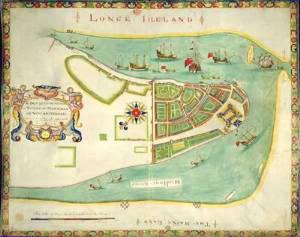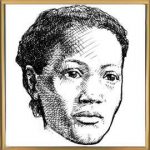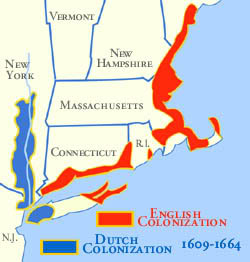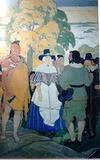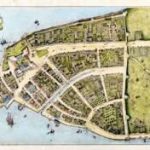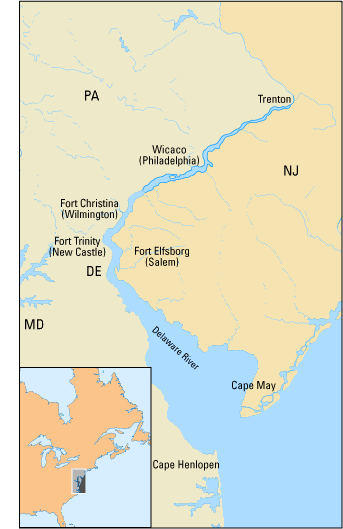The Years: 1625 through 1664
Image: New Amsterdam Map
Dutch New Amsterdam
In 1624, the Dutch West India Company (DWIC) began settling the colony of New Netherland, the territory granted to the Dutch West India Company in 1621 by the government of Holland. It stretched from Manhattan to Albany along both sides of the Hudson River, and eventually included the areas now known as New York and New Jersey, and parts of Delaware and Connecticut. This colony was set up as a business, and its main goal was to make money for the DWIC by trading beaver pelts and other goods with Europe.
In 1625, the DWIC established the village of New Amsterdam, the main settlement in the Colony at the tip of Manhattan Island. There weren’t enough colonists to do the work of establishing a new colony. The Company tried to persuade more Dutch people to come to the colony, but few were interested. They tried to make local Native Americans work, but they ran off and returned to their villages. Bringing the captured African seamen to New Amsterdam seemed to solve these problems. Africans could be forced to work, and they couldn’t escape and go home.
The use of African slaves began in the 1400s, when Europeans began buying prisoners of war from African kings. By the time New Amsterdam was founded, Europeans were used to the idea of African slaves. Europeans believed that people were born to a certain role in life, whether they were white or black, male or female, rich or poor. They saw that as the natural order of things. They believed that white Christians, especially white Christian men, were meant to be in control and lead the world toward greater progress.
The world in the early 1600s was not sharply divided between people who were free and people who were not. There were many people in Europe and the American colonies who weren’t really free: indentured servants under contract for several years, apprentices who were bound to a tradesman while they learned a skill, and tenants farming land owned by a landlord.
Africans at New Amsterdam
Circa 1626, eleven bondsmen were brought to New Amsterdam. They had Portuguese names and were probably captured from Portuguese or Spanish ships. In 1627, the first three enslaved women were brought to New Amsterdam, which was still little more than a muddy village with thirty wooden houses and a population of less than two hundred people.
For much of the Dutch colonial period, the slaves were owned directly by the Dutch West India Company, and they worked for the colony. They cleared land, planted and harvested crops, and built houses, roads, and bridges. They built Fort Amsterdam, cut the road that became Broadway, and fortified a wall along a path that would later be known as Wall Street. Without their work, the colony of New Amsterdam might not have survived.
The legal and social status of the enslaved Africans was originally not clearly defined. They basically followed the same laws as the white population, meaning they could own property and testify in court, bear arms in emergencies, attend church, and marry. Soon, individual Dutch families began buying slaves, and that pattern continued into the British colonial period.
By the late 1630s, there were 100 enslaved men and women in New Amsterdam, amounting to one-third of the population. Other colonies owned slaves, too, but there were many more in New Amsterdam. Africans in New Amsterdam wore Dutch clothing, learned the Dutch language, and adopted their customs. They were married in the Dutch church, and their children were registered with the company. The Colony passed very few laws to control its slaves.
In 1635, the Dutch West Indies company hired a special overseer to supervise the work of “the Negroes belonging to the company.” Separate slave quarters were established along the East River north of the main settlement.
Half-Freedom
As the settlement became well established, the need for slaves diminished, and the eleven men who had first arrived in the Colony petitioned the Company for their freedom. In 1644, these men and their wives received conditional liberty, sometimes called half-freedom. They received the title to land on the outskirts of the colony, where they would act as a buffer against attack from Native Americans. In return, they must pay an annual tax in produce and work for the colony whenever their labor was needed. Their children, however, would remain forever enslaved.
Land of the Blacks
But they no longer had to live like slaves. They farmed their own lands, sold their produce, and kept the profits beyond what they owed in tax. Black farmers soon owned a two-mile long strip of land from what is now Canal Street to 34th Street in Manhattan. The sizes of the individual land grants varied, but most were from two to eight acres. These former slaves created the first black community in Manhattan, on farms granted them in the Land of the Blacks, located where Washington Square is now. The total area was more than 130 acres, or about 100 city blocks.
Peter Stuyvesant
In 1647, Peter Stuyvesant became the Director General of New Netherland. His job was to bring order to the loosely-structured colony. Because of labor shortages, Africans gained access to skilled trades. Under Stuyvesant’s direction, enslaved Africans labored as caulkers making boats watertight, blacksmiths, bricklayers and masons. Some were welcomed into the Dutch Reformed Church, where they were offered education and religious training, and were allowed to marry and baptize their children.
Stuyvesant corresponded with company officials in the Netherlands about the need to import more enslaved Africans. He increased the number of enslaved Africans in the colony, and became the largest individual owner of enslaved Africans in the colony. The direct trade in slaves between New Amsterdam and Africa began in 1655, with the arrival of a ship containing 300 enslaved Africans. In 1660, Stuyvesant supervised what was probably Manhattan’s first public auction of human beings.
By 1664, the African population was had increased to 800 people, ten percent of the total population of New Netherland. In New Amsterdam, 375 Africans made up about a fourth of the population. A 1664 tax list showed that approximately one out of eight citizens in New Amsterdam owned slaves, including a number of large plantations in Hempstead in what would become Queens County.
English New York
In 1664, the English seized New Amsterdam and integrated it into their own imperial economy of sugar and slaves. Trading in food, wood, and animals with the British West Indies enriched the city’s merchants. Slave numbers grew after 1700 as merchants, farmers, and artisans relied more and more on their labor. By the 1740s, 20% of New York’s inhabitants were slaves and two out of every five households had at least one. Repressive laws were written to control them but the enslaved conspired, rebelled, and ran away relentlessly.
Dutch New Netherland came under British control in 1664. The colony and the settlement on Manhattan Island were renamed New York in honor of James II, the Duke of York. James was a major shareholder in the Royal African Company, which held a royal monopoly on the British slave trade.
With the British in power, slave trading vessels were granted port privileges, and a slave market was established on Wall Street near the East River docks. Laws were passed to control the status and behavior of enslaved Africans, and their lives became more regulated.
SOURCES
The Dutch Period—PDF File
White New Yorkers—PDF File
